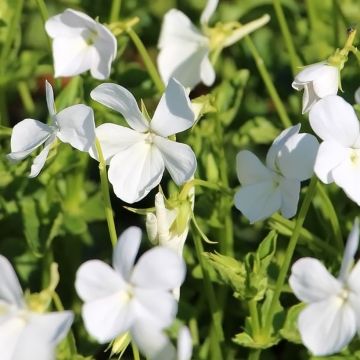

Primevère - Primula elatior Veristar Late Red
Primula eliator Veristar Late Red F1 - Oxlip
Primula x eliator Veristar Late Red F1
Oxlip
This plant carries a 6 months recovery warranty
More information
We guarantee the quality of our plants for a full growing cycle, and will replace at our expense any plant that fails to recover under normal climatic and planting conditions.
From €5.90 for pickup delivery and €6.90 for home delivery
Express home delivery from €8.90.
From €5.90 for pickup delivery and €6.90 for home delivery
Express home delivery from €8.90.
Does this plant fit my garden?
Set up your Plantfit profile →
Description
The Primula 'Veristar Late Red F1' is a hybrid primrose that impresses with its performance in the garden and its flowering, which is both generous and richly coloured. This small, beautifully bushy plant produces numerous flower stalks, each carrying flowers richly coloured from red to golden-hearted. Very beautiful in borders, it is also a hardy variety, perennial to biennial, ideal for ornamental containers. You should plant it in a sunny but not scorching position, in soil enriched with compost, fertile and moist.
Primroses belong to the primrose family. The Primula elatior, also known as Oxlip or Cowslip, is a herbaceous perennial plant that belongs to our native flora and is mostly found in the semi-shade of clear woodlands or at the edge of forests. When abundant, this species, sometimes called the cuckoo flower, is an indicator of old forests, little disturbed by human activity. This plant has produced many short-lived perennial hybrids, often grown as biennial plants, through hybridisation with the common primrose (Primula vulgaris). This 'Veristar Late Red' primrose blooms from late January if protected from the cold, but more commonly in March, depending on the climate, for about 4-5 weeks. On each plant, several flower stalks, 20-25 cm (8-10in) tall, each carry several single flowers, 3 cm (1in) in diameter, composed of rounded petals. Their colour is well highlighted by evergreen foliage in rosettes of large, deeply-veined dark green leaves, ornamental even outside of the flowering period.
Elatior primroses are less well-known than stemless primroses, but they have their own advantages: they are taller, hardier, more long-lived, and their flowering is also more spectacular. They are excellent companions for shade-loving and cool, clear understory perennials such as heucheras, Brunnera, forget-me-nots, horned violets, and hostas. They also allow for decoration of the terrace, window, or balcony, planted in containers that will brighten up spring scenes. They also hold up very well in a simple bouquet, mixed with forget-me-nots or early tulips.
Report an error about the product description
Primula eliator Veristar Late Red F1 - Oxlip in pictures






Flowering
Foliage
Plant habit
Botanical data
Primula
x eliator
Veristar Late Red F1
Primulaceae
Oxlip
Cultivar or hybrid
Other Pansies and violas
Planting and care
The primroses 'Veristar Late Red' are planted in pots and planters or directly in the ground in a finely prepared soil enriched with compost, not too chalky. Plant them if possible upon receipt, in September-October or in March-April. If the planned location is not yet ready or if the conditions are unfavorable for planting, you can grow them as plug plants for 4 to 6 weeks. Choose a sunny exposure, but not scorching.
In pots and planters, use a good soil for flowering plants (geranium-type soil) enriched with clay and slow-release fertiliser, light and well-draining. The top of the plug plant should be level with the soil. Water generously at planting and during the following weeks, as the plug plants can dry out quickly. However, be careful not to overwater! Make sure to use containers with drainage holes and empty the saucer 10 minutes after watering. Remember to water even during winter if it doesn't rain or if the container is placed in a sheltered location from precipitation. Do not water during freezing periods.
Very floriferous and fast-growing, primroses are vigorous plants. As soon as growth resumes, at the end of February or beginning of March, and throughout the flowering period, apply a liquid fertiliser for flowering plants containing iron and trace elements 1 to 2 times a week with the water. Remove faded flowers to promote new flowerings. Once the flowering is over, plants in pots can be planted in the garden in partial shade.
Planting period
Intended location
Care
-
, onOrder confirmed
Reply from on Promesse de fleurs
Plug plants - Annuals
Haven't found what you were looking for?
Hardiness is the lowest winter temperature a plant can endure without suffering serious damage or even dying. However, hardiness is affected by location (a sheltered area, such as a patio), protection (winter cover) and soil type (hardiness is improved by well-drained soil).

Photo Sharing Terms & Conditions
In order to encourage gardeners to interact and share their experiences, Promesse de fleurs offers various media enabling content to be uploaded onto its Site - in particular via the ‘Photo sharing’ module.
The User agrees to refrain from:
- Posting any content that is illegal, prejudicial, insulting, racist, inciteful to hatred, revisionist, contrary to public decency, that infringes on privacy or on the privacy rights of third parties, in particular the publicity rights of persons and goods, intellectual property rights, or the right to privacy.
- Submitting content on behalf of a third party;
- Impersonate the identity of a third party and/or publish any personal information about a third party;
In general, the User undertakes to refrain from any unethical behaviour.
All Content (in particular text, comments, files, images, photos, videos, creative works, etc.), which may be subject to property or intellectual property rights, image or other private rights, shall remain the property of the User, subject to the limited rights granted by the terms of the licence granted by Promesse de fleurs as stated below. Users are at liberty to publish or not to publish such Content on the Site, notably via the ‘Photo Sharing’ facility, and accept that this Content shall be made public and freely accessible, notably on the Internet.
Users further acknowledge, undertake to have ,and guarantee that they hold all necessary rights and permissions to publish such material on the Site, in particular with regard to the legislation in force pertaining to any privacy, property, intellectual property, image, or contractual rights, or rights of any other nature. By publishing such Content on the Site, Users acknowledge accepting full liability as publishers of the Content within the meaning of the law, and grant Promesse de fleurs, free of charge, an inclusive, worldwide licence for the said Content for the entire duration of its publication, including all reproduction, representation, up/downloading, displaying, performing, transmission, and storage rights.
Users also grant permission for their name to be linked to the Content and accept that this link may not always be made available.
By engaging in posting material, Users consent to their Content becoming automatically accessible on the Internet, in particular on other sites and/or blogs and/or web pages of the Promesse de fleurs site, including in particular social pages and the Promesse de fleurs catalogue.
Users may secure the removal of entrusted content free of charge by issuing a simple request via our contact form.
The flowering period indicated on our website applies to countries and regions located in USDA zone 8 (France, the United Kingdom, Ireland, the Netherlands, etc.)
It will vary according to where you live:
- In zones 9 to 10 (Italy, Spain, Greece, etc.), flowering will occur about 2 to 4 weeks earlier.
- In zones 6 to 7 (Germany, Poland, Slovenia, and lower mountainous regions), flowering will be delayed by 2 to 3 weeks.
- In zone 5 (Central Europe, Scandinavia), blooming will be delayed by 3 to 5 weeks.
In temperate climates, pruning of spring-flowering shrubs (forsythia, spireas, etc.) should be done just after flowering.
Pruning of summer-flowering shrubs (Indian Lilac, Perovskia, etc.) can be done in winter or spring.
In cold regions as well as with frost-sensitive plants, avoid pruning too early when severe frosts may still occur.
The planting period indicated on our website applies to countries and regions located in USDA zone 8 (France, United Kingdom, Ireland, Netherlands).
It will vary according to where you live:
- In Mediterranean zones (Marseille, Madrid, Milan, etc.), autumn and winter are the best planting periods.
- In continental zones (Strasbourg, Munich, Vienna, etc.), delay planting by 2 to 3 weeks in spring and bring it forward by 2 to 4 weeks in autumn.
- In mountainous regions (the Alps, Pyrenees, Carpathians, etc.), it is best to plant in late spring (May-June) or late summer (August-September).
The harvesting period indicated on our website applies to countries and regions in USDA zone 8 (France, England, Ireland, the Netherlands).
In colder areas (Scandinavia, Poland, Austria...) fruit and vegetable harvests are likely to be delayed by 3-4 weeks.
In warmer areas (Italy, Spain, Greece, etc.), harvesting will probably take place earlier, depending on weather conditions.
The sowing periods indicated on our website apply to countries and regions within USDA Zone 8 (France, UK, Ireland, Netherlands).
In colder areas (Scandinavia, Poland, Austria...), delay any outdoor sowing by 3-4 weeks, or sow under glass.
In warmer climes (Italy, Spain, Greece, etc.), bring outdoor sowing forward by a few weeks.















































